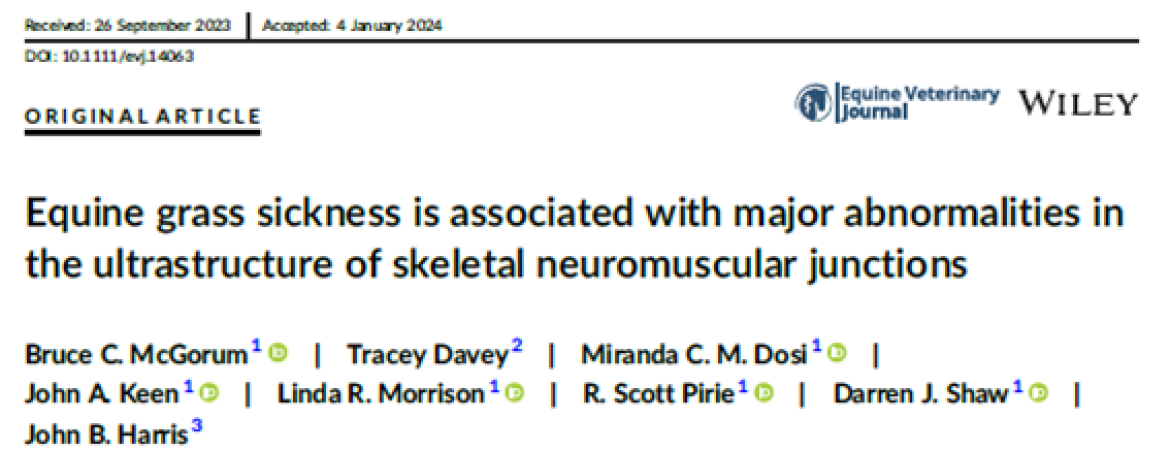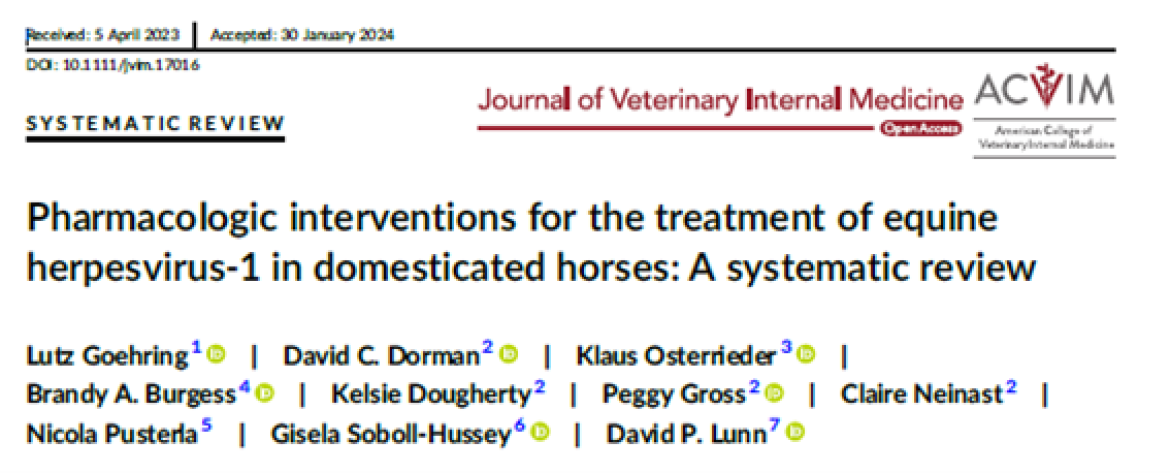
Infectious diseases

This multidisciplinary Equine Grass Sickness group has recently published a study comparing the structural integrity of the neuromuscular junction (NMJ) in intercostal and diaphragm skeletal muscles of healthy horses, horses affected by Equine Grass Sickness and one horse with a clinical diagnosis of botulism. The authors identified distinct differences between the ultrastructural abnormalities found in neuromuscular junctions of skeletal muscle samples of horses affected by EGS versus the horse affected by botulism. Given that the NMJ abnormalities in the EGS cases were inconsistent with the effects of botulinum toxin, the authors concluded that the NMJ may be a previously unrecognised target for the toxin that causes Equine Grass Sickness.
https://doi.org/10.1111/evj.14063

This study investigated prognostic factors in 46 horses diagnosed with equine multinodular pulmonary fibrosis (EMPF). Key clinical signs included weight loss (78%), dyspnoea (72%), tachypnoea (70%) and fever (39%). Bronchoalveolar lavage fluid (BALF) demonstrated macrophage atypia more frequently in EMPF cases than in severe equine asthma cases (67% vs. 8%; P = .02). Equine herpesvirus 5 (EHV-5) was detected in BALF in 80% of cases and plasma hyperfibrinogenaemia was present in 89% of cases. Survival rates were 59% at discharge and 24% at three months post-discharge. Survival was more likely in cases with lower respiratory rates, higher BALF lymphocyte-to-neutrophil ratio, and increased blood lymphocyte counts. Presence of fever and diagnostic imaging findings were unreliable predictors, and corticosteroid use did not improve survival. Horses presenting with weight loss, respiratory distress, and tachypnoea should be evaluated, as EMPF carries a poor prognosis.
https://doi.org/10.1111/jvim.17084

This systematic review examines the efficacy of pharmacological interventions in reducing the incidence or severity of equine herpesvirus type 1 (EHV-1) infection, associated with respiratory and neurological disease, abortion, and neonatal death in horses. A literature search of six major databases identified 7009 studies, of which nine met inclusion criteria for evaluating therapeutic agents in vivo. Investigated treatments included valacyclovir, small interfering RNAs, a Parapoxvirus ovis-based immunomodulator, human alpha interferon, herbal supplements, cytosine analogs, and heparin. Evidence quality varied from randomised clinical to observational studies with moderate to high risk of bias and small sample sizes. The majority of pharmacological interventions demonstrated limited or no significant efficacy in preventing or mitigating EHV-1 disease outcomes. The findings suggest minimal clinical utility for the pharmacological approaches evaluated, in managing EHV-1 infection.
https://doi.org/10.1111/jvim.17016

This study investigated the prevalence of subclinical equine parvovirus hepatitis (EqPV-H) infection and its potential transmission routes in 116 hospitalized horses admitted for non-hepatic conditions. Serum, faeces, nasal, and buccal swabs were analyzed for EqPV-H DNA using quantitative and nested PCR, and antibodies were detected via a luciferase immunoprecipitation assay. Seroprevalence was 10.3%, with 12.9% of seropositive horses demonstrating viraemia; serum viral loads ranged from undetectable to 1.3 × 10⁶ genome equivalents/mL. Low levels of EqPV-H DNA were found in nasal swabs and faeces. These findings suggest a potential risk of transmission to susceptible horses in an hospital setting and underline the importance of screening potential equine blood and plasma donors to prevent iatrogenic spread.
https://doi.org/10.1111/jvim.17129

This retrospective study describes clinical and diagnostic features of acute systemic leptospirosis in 11 horses presented between 2015 and 2023. Key clinical signs included lethargy, anorexia, fever, tachypnoea, abnormal lung sounds, and epistaxis. Acute kidney injury was observed in all cases, with pulmonary haemorrhage and liver disease affecting 73% and 55% of horses, respectively. Multi-organ involvement (kidneys, lungs, liver) occurred in 55% of cases. Urine PCR testing for pathogenic Leptospira spp. was positive in 55%, and serology identified Leptospira interrogans serovars Australis, Autumnalis, and Bratislava in 86% of titers ≥1:800. Case fatality was 36%, with necropsy revealing tubular necrosis, interstitial nephritis, alveolar haemorrhage, pulmonary oedema, periportal hepatitis, and cholangitis. Leptospirosis should be considered in horses with acute inflammation, renal injury, or hepatic signs, and diagnosis is improved by combining serology and urine PCR testing.
https://doi.org/10.1111/jvim.17184